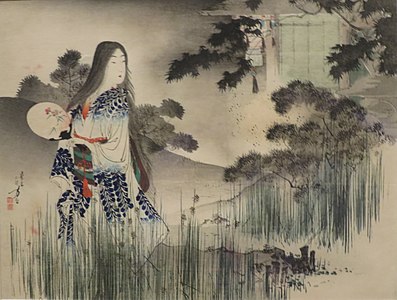Kuchi-e

Kuchi-e (口絵) (lit. 'mouth pictures')
They usually portrayed women and were bound to the book's spine or inserted into literary magazines to give readers a sense of what type of stories were to unfold. Most kuchi-e were woodblock prints in romance novels intended for a female audience. Some were lithographs, and some were inserted into other types of literature. The first mass-produced publication to regularly feature kuchi-e designs popular literary magazine Bungei Kurabu, with over 230 individual inserted from 1895 to 1914. Most measured either 22 cm × 30 cm (8.7 in × 11.8 in) or 14 cm × 20 cm (5.5 in × 7.9 in), the former being folded in thirds, and the latter being folded in half.[3]
The general standard of kuchi-e prints is remarkably high. Made at a time of well developed woodblock printing techniques, it is thought the addition of these prints contributed to almost half the cost of production. Still, the genre is under-appreciated as an artfrom by the majority of print collectors. The standard text on the subject is Merritt and Yamada's Woodblock Kuchi-e Prints—Reflections of Meiji Culture (2000).
Practitioners
Artists who designed kuchi-e include
Translation
The word kuchi-e (口絵) is usually translated into English as mouth (kuchi) picture (e).[2] However, kuchi (口) may also mean "opening", as it does in the compound words iri-guchi (入口, entrance) and de-guchi (出口, exit). In this way, the translation "entrance picture" more clearly communicates the intended function of a kuchi-e as a frontispiece in a literary work.[5]
Gallery
-
"Lady in Wisteria Kimono", Mizuno Toshikata, c. 1900, Honolulu Museum of Art
-
"Beauty Sketching in a Field", Mizuno Toshikata, 1903, Honolulu Museum of Art
-
Woodblock kuchi-e for Ai ai gasa by Ikeda Terukata and Shōen, 1914
-
"A Mother's Love", Yamakawa Shūhō 1924
References
- ISBN 978-0-8248-2073-2.
- ^ a b Newland, p. 463
- ^ a b Artlino
- ^ Oberlin College website
- ^ Personal communication with Stephen Salel, Robert F. Lange Foundation Assistant Curator of Japanese Art, Honolulu Museum of Art
Sources
- Newland, Amy Reigle. (2005). Hotei Encyclopedia of Japanese Woodblock Prints. Amsterdam: Hotei
- Merritt, Helen and Yamada Nanako, Woodblock Kuchi-e Prints--Reflections of Meiji Culture, University of Hawaii Press, Honolulu, 2000, ISBN 0824820738
- Nanako, Yamada, "Beauties as Frontispieces" in Daruma Magazine, Issue 32, Vol. 8, No. 4, pp. 40–48, 2001
External links
![]() Media related to Kuchi-e at Wikimedia Commons
Media related to Kuchi-e at Wikimedia Commons
- "Kuchi-e," or Literary Magazine Frontispieces Ukiyo-e Gallery
- Making a kuchi-e print Video by David Bull (34 mins)





